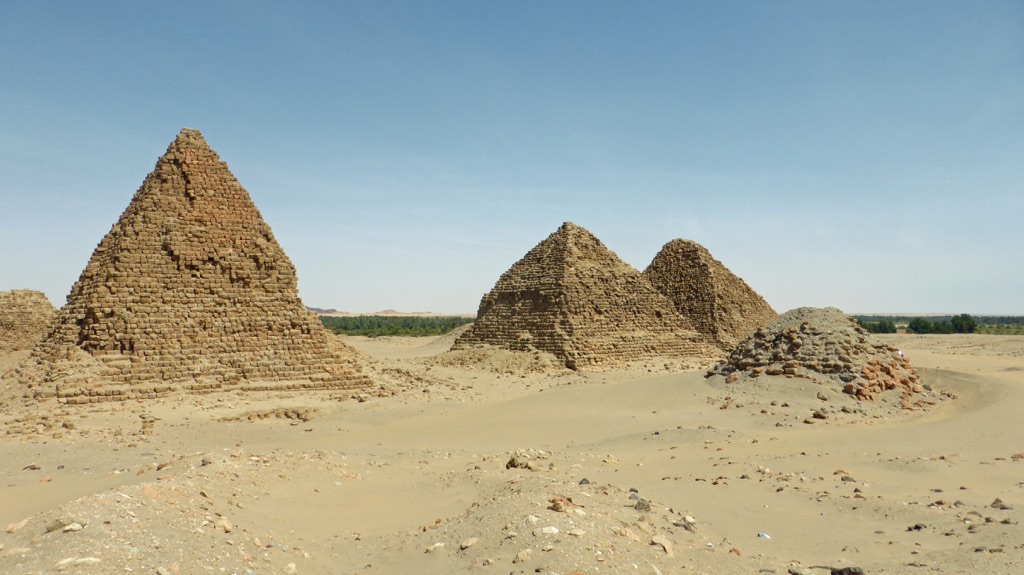The Nuri Pyramids, a captivating cluster of ancient structures, lie in the heart of Sudan’s desert. These pyramids served as the burial grounds for the Kushite kings and queens. The site, less known than its Egyptian counterparts, offers a unique glimpse into the Nubian civilization that flourished along the Nile. The Nuri Pyramids stand as a testament to the architectural prowess and the cultural significance of the Kingdom of Kush.
Get your dose of History via Email
Historical Background of Nuri Pyramids
The Nuri Pyramids, nestled in Sudan’s arid landscape, are remnants of the ancient Kingdom of Kush. Archaeologist George Reisner first unearthed them in 1916. The Kushites built these pyramids as tombs for their royalty, mirroring Egyptian practices. The largest pyramid at Nuri belonged to Taharqa, a pharaoh who also ruled over Egypt. Over time, the site fell into obscurity, only to be rediscovered and brought to light by Reisner’s efforts.
Construction of the Nuri Pyramids began with Taharqa, around 670 BCE. The Kushite kingdom, having close ties with Egypt, adopted many of their customs, including pyramid building. However, the Nuri Pyramids exhibit distinct features, such as steeper sides and smaller bases. These structures symbolized the might and spirituality of the Kushite rulers.
After the Kushite dynasty lost control of Egypt, they continued to rule from Nubia. The Nuri Pyramids became the final resting place for over twenty kings and queens. The site also witnessed later habitation, although details are sparse. The pyramids have not been the scene of any known historical events since their construction, but they remain a significant archaeological site.
Despite their grandeur, the Nuri Pyramids have suffered from the ravages of time. Natural erosion and human activity have taken their toll. Yet, they continue to attract archaeologists and historians, eager to uncover more about the Kushite civilization. The pyramids’ construction techniques and the artifacts found within offer valuable insights into this ancient culture.
The Nuri Pyramids, though not as famous as those in Giza, hold their own in historical importance. They serve as a bridge between the Egyptian and Kushite civilizations. The site’s rediscovery has allowed for a greater understanding of the Nubian people and their contributions to history.
About Nuri Pyramids
The Nuri Pyramids stand as a collection of over 20 pyramids and tombs. They were built from sandstone blocks and feature steep angles, distinct from their Egyptian counterparts. The largest pyramid, belonging to King Taharqa, measures over 50 meters wide at its base. The pyramids’ architectural style reflects a blend of Egyptian influence and indigenous Kushite elements.
Builders used local sandstone to construct the pyramids, which has weathered over the centuries. The pyramids’ interiors included burial chambers, which housed the mummified remains of the kings and queens, along with valuable artifacts. These chambers were accessed through steep and narrow passages, designed to deter tomb robbers.
The craftsmanship of the Nuri Pyramids showcases the skill of Kushite builders. They employed advanced techniques to align the pyramids with astronomical events. This alignment suggests a deep understanding of celestial patterns and their significance in Kushite culture.
Over time, the harsh desert environment has eroded the pyramids’ exteriors. However, many of the structures still stand, albeit in a dilapidated state. Conservation efforts are underway to preserve these historical treasures for future generations.
The Nuri Pyramids, though not as grandiose as those in Egypt, offer a unique perspective on the architectural achievements of the Kushite civilization. Their design and construction methods provide a window into the technological capabilities of this ancient African kingdom.
Theories and Interpretations
Several theories surround the Nuri Pyramids, particularly regarding their purpose and construction. Scholars believe these pyramids served as tombs, a practice adopted from the Egyptians. The steep angles of the pyramids are thought to represent the Kushite interpretation of the Egyptian pyramid form.
Mysteries linger about the exact rituals and ceremonies performed at the Nuri Pyramids. The presence of burial chambers suggests a belief in an afterlife, where the deceased would need their earthly possessions. However, the specifics of these beliefs are still subject to interpretation.
Historians have matched the pyramids to their royal occupants through inscriptions and artifacts found within. These findings have helped to construct a timeline of the Kushite rulers. Dating of the site has been carried out using various methods, including radiocarbon dating and analysis of pottery styles.
Theories about the construction of the Nuri Pyramids include the use of ramps and levers, similar to methods hypothesized for Egyptian pyramid construction. The precise alignment of the pyramids with astronomical events also suggests advanced knowledge of astronomy and mathematics.
The Nuri Pyramids continue to be a focus of research and debate among historians and archaeologists. Each discovery at the site adds a piece to the puzzle of the Kushite civilization and its connections to the broader ancient world.
At a glance
- Country: Sudan
- Civilization: Kingdom of Kush
- Age: Approximately 2,700 years old (circa 670 BCE)
Conclusion and Sources
- Wikipedia – https://en.wikipedia.org/wiki/Nuri
- World History Encyclopedia – https://www.worldhistory.org/kush/

